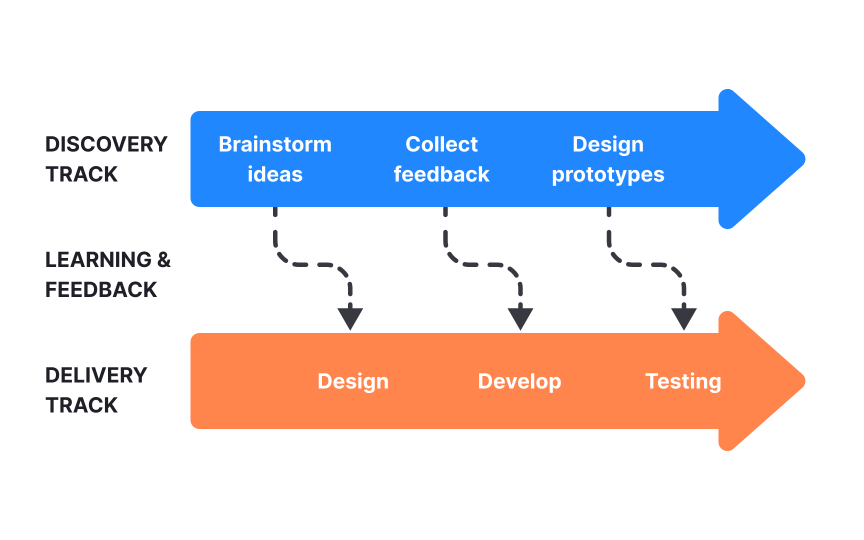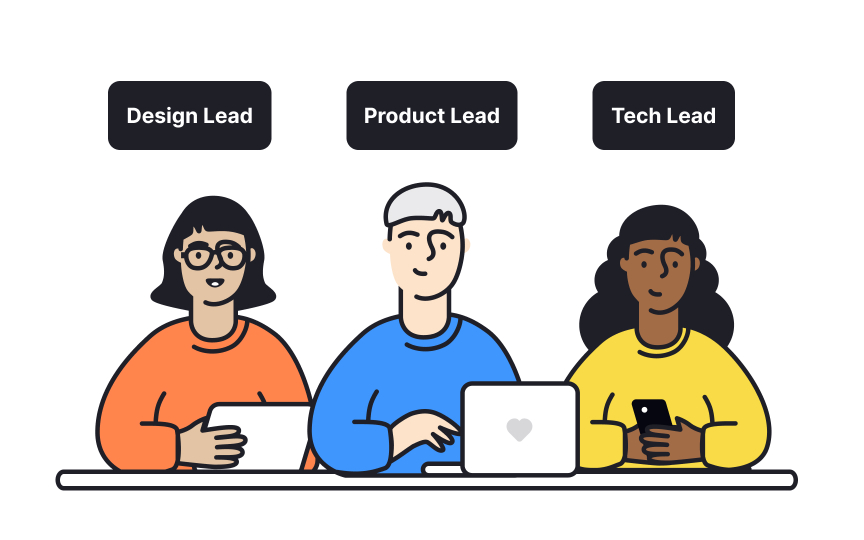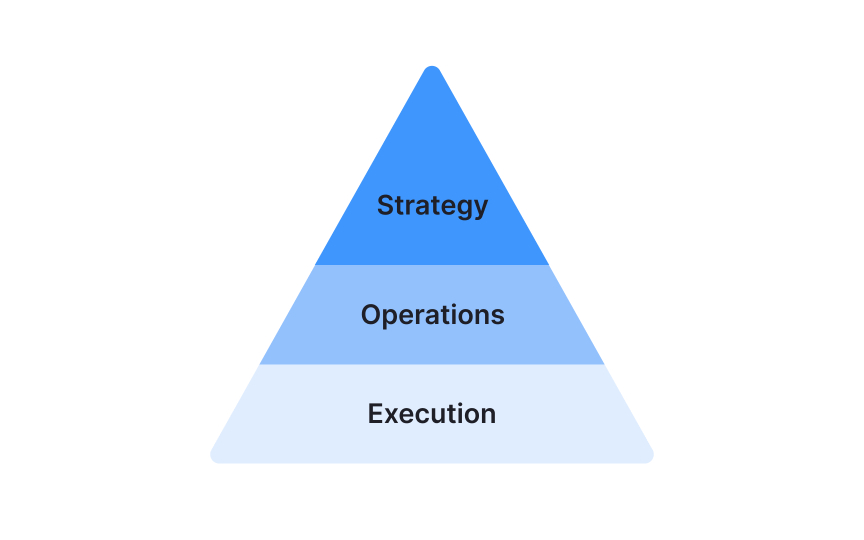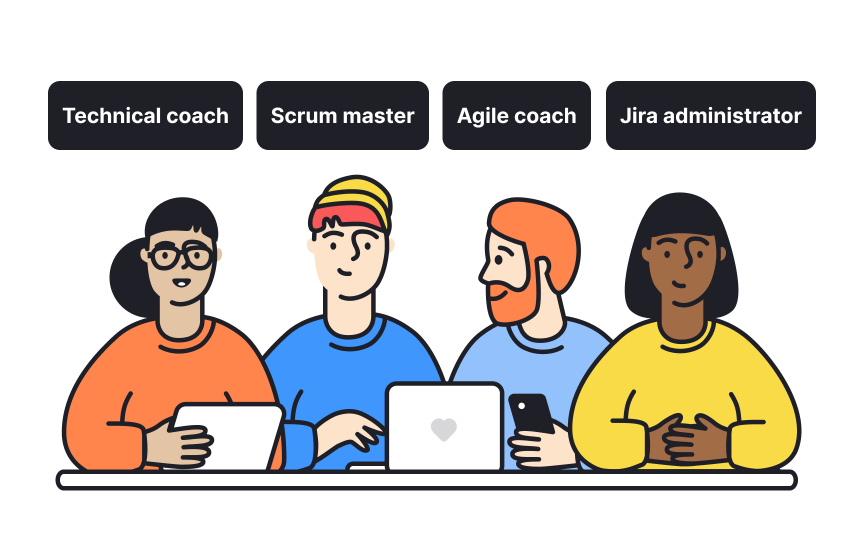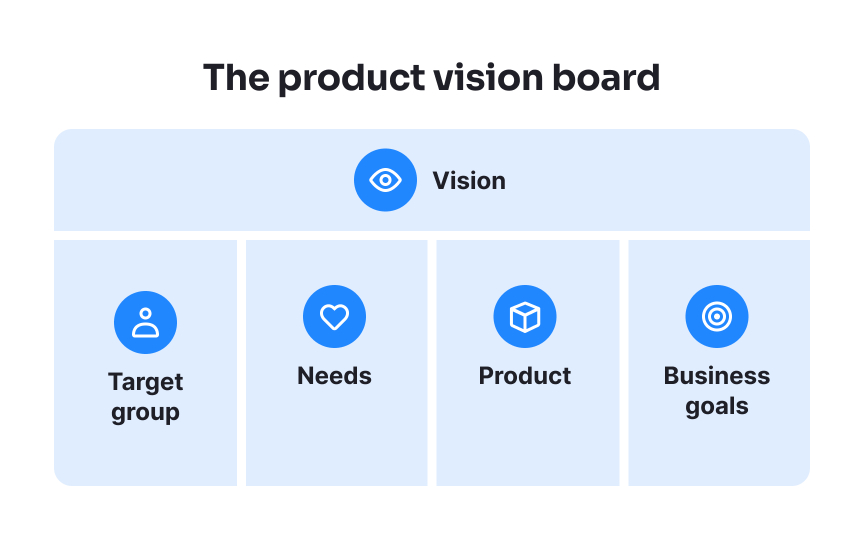Agile at Scale
Master essential techniques for scaling agile while maintaining both alignment and speed.
Scaling agile practices across growing organizations presents unique challenges that go beyond standard team-level implementations. As companies expand, maintaining agility requires thoughtful approaches to structure, collaboration, and decision-making. The balance between alignment and autonomy becomes critical: too much control stifles innovation, while too little creates chaos. Organizations that successfully scale agile adopt specialized techniques like dual-track development, cross-functional triads, and layered organizational structures.
These approaches preserve agile's core values while adapting to the complexities of larger teams and multiple workstreams. The journey to scaled agility isn't about rigid frameworks, but about creating conditions where teams can collaborate effectively while maintaining speed and responsiveness, even as organizational complexity increases.
Dual Track Agile divides product development into two parallel streams:
- Discovery. Teams research user needs, test ideas, and validate potential solutions. Discovery teams can conduct deeper research without blocking development progress.
- Delivery. Teams build, test, and ship solutions that have already been validated. Delivery teams maintain consistent velocity because they always have validated work to build.
Teams can also specialize based on their strengths, with more research-oriented members focusing on discovery.
The biggest challenge is avoiding a waterfall-like handoff culture. When discovery happens without delivery team involvement, teams risk creating silos where designers and product managers validate solutions, then simply hand specifications to developers.
Successful implementation requires strong connections between tracks: invite developers to discovery sessions, hold regular sync meetings, deliver in smaller chunks rather than big designs, and ensure both tracks share common goals and metrics. Remember, the goal isn't to divide teams but to organize work modes while maintaining collaboration.
Pro Tip: Start with a weekly synchronization meeting between the discovery and delivery teams to ensure alignment on priorities and learnings.
The Triad model is a balanced approach that prevents products from emphasizing one dimension at the expense of others. There are 3 essential perspectives in product discovery:
- The Product Lead focuses on business strategy, market opportunities, and revenue potential. They own prioritization and break ties when needed.
- The Design Lead advocates for user needs, experience quality, and usability. They drive
research and validate that solutions solve real problems. - The Technical Lead assesses implementation feasibility, identifies risks, and spots technical opportunities others might miss.[1]
When working together, each role brings unique value to discovery activities. For exploring ideas, design brings user insights, product provides business context, and tech adds implementation perspective. For prioritization, tech estimates effort, design assesses user value, and product weighs strategic importance. For this model to succeed, all 3 leads must participate from the beginning of discovery, engage in healthy debate before decisions, and operate within reasonable timeboxes to prevent analysis paralysis. When implemented well, the Triad creates natural creative tension that leads to more balanced, successful products.
Pro Tip: Schedule regular "Triad time" where all 3 leads can discuss upcoming initiatives before they're fully defined to catch potential issues early.
As organizations grow, separating roles across 3 layers helps maintain focus and effectiveness:
- The Strategy layer includes directors, principal designers, and architects, and focuses on long-term vision and direction.
- The Operations layer includes practice leads and coaches and enables effective ways of working.
- The Execution layer includes product managers, designers, and developers and delivers day-to-day customer value.
This separation allows each layer to focus on what it does best. Strategy can think long-term without getting pulled into daily work. Operations can improve practices and tools without delivery pressure. Execution can focus on customer value without constantly shifting direction.
However, this model risks creating handoffs where strategy plans, operations create processes, and execution simply implements. To prevent this, maintain continuous communication between layers, position strategy and operations as enablers rather than controllers, and preserve cross-functional collaboration at the execution level. Each discipline contributes differently across layers. For example, in product management, strategy handles portfolio planning, operations provides workflow templates and coaching, and execution manages sprint planning and stakeholder communication. This specialization helps organizations scale while maintaining both speed and alignment.
Pro Tip: Create regular feedback channels where execution teams inform strategic decision-making to ensure high-level direction stays connected to implementation realities.
As organizations scale agile across multiple teams, dependencies between workstreams often become a major obstacle to agility. When teams must coordinate extensively to deliver value, delivery becomes slower and less predictable. Successful organizations create clear visibility into cross-team dependencies through visual management boards, tracking tools, or dedicated coordination roles. Regular synchronization meetings like Scrum of Scrums allow team representatives to discuss integration points and blockers.
Team structure significantly impacts dependency management. Teams organized around customer journeys typically have fewer dependencies than those structured around technical components. When separate teams own different technical layers of a feature, they need extensive coordination to deliver anything valuable.[2] Technical practices also help manage dependencies: API contracts help teams agree on interfaces before implementation, feature toggles enable continuous integration while controlling what's visible to users, and trunk-based development reduces integration problems. Organizations should continuously work to reduce unnecessary dependencies through architectural decisions and team autonomy, measuring success by how little coordination they require.
Several frameworks help organizations scale agile principles beyond individual teams:
- SAFe (Scaled Agile Framework) organizes teams into "Agile Release Trains" that work in synchronized Program Increments (8-12 weeks). It provides detailed guidance on roles and ceremonies at team, program, and portfolio levels, making it suitable for large organizations with complex dependencies.
- LeSS (Large-Scale Scrum) takes a minimalist approach. It extends Scrum across multiple teams who share a single product backlog and sprint timeline, with one Product Owner. LeSS emphasizes simplicity and whole-product focus with minimal additional processes.
- The Spotify model organizes teams (Squads) around product capabilities, grouped into business-aligned Tribes while maintaining functional communities (Chapters). This balances autonomy with alignment and knowledge sharing.
While these frameworks offer valuable patterns, implementing them rigidly often disappoints. Successful organizations adapt frameworks to their specific challenges rather than following them exactly. Start incrementally with the patterns that address your immediate issues, then expand based on results.
Pro Tip: Before adopting any scaled framework, identify your specific challenges and implement only the elements that directly address them.
Agile enablement teams support organizations in scaling agile successfully through specialized expertise. These teams typically include:
- Agile coaches who help teams apply
agile principles effectively, facilitate challenging ceremonies, and resolve team dynamics issues. - Scrum Masters or Kanban specialists who train teams on specific methodologies, help establish effective workflows, and coach teams through implementation challenges.
- Technical practice coaches who guide teams in adopting engineering practices like test automation, continuous integration, and refactoring techniques.
- Tool administrators who configure and support agile management platforms (like Jira, Azure DevOps, or Rally), create useful dashboards, and help teams use these tools effectively.
Unlike external consultants, internal enablement teams understand the organization's specific context and culture. They can provide continuous support over time, building relationships and tailoring their approach to each team's unique needs. The most effective enablement teams focus on capability building rather than doing the work themselves. They might temporarily fill roles like Scrum Master, but always with the goal of transferring knowledge and skills. Success should be measured not by how many teams depend on them, but by how many teams become self-sufficient. Enablement teams should position themselves as mentors and capability builders who work toward making themselves unnecessary, not as process police or permanent facilitators who create dependency.
Pro Tip: Have your agile enablement team create a "graduation plan" for each team they support, defining capabilities needed before reducing direct coaching.
The fundamental challenge in scaled agile is balancing team autonomy with organizational alignment. Teams need autonomy to innovate and feel ownership. Organizations need alignment to move in a coordinated direction and create a coherent customer experience. Too much autonomy leads to fragmentation, and teams optimize locally but create inconsistent products or duplicate efforts. Too much control creates bottlenecks, demotivates teams, and slows responsiveness to market changes. Successful organizations achieve balance through outcome-based objectives rather than prescribed solutions. They define what teams should achieve (customer outcomes, business metrics) while giving teams flexibility in how they achieve these results. Clear boundaries help by explicitly defining what must be standardized versus where teams have flexibility.
For example, organizations might standardize design systems and security practices while giving teams freedom in feature implementation. Leaders should focus on sharing context and clarifying the "why" behind initiatives while giving teams space on the "how." When teams understand the reasoning behind strategic priorities, they can make better local decisions.
Pro Tip: Use techniques like "Delegation Poker" to explicitly clarify which types of decisions require alignment versus where teams have full autonomy.
As organizations scale, traditional metrics like velocity become insufficient. Effective measurement must balance team health with organizational flow.
Flow metrics provide visibility into system-wide performance:
- Cycle time shows how long work takes, helping identify bottlenecks
- Throughput consistency reveals the reliability of value delivery
- Flow efficiency measures active work versus waiting time
Leading indicators provide early warning before problems affect delivery. Metrics like dependency resolution rates and feature cycle time trends allow proactive intervention rather than reactive fixes.
Technical health metrics ensure sustainable delivery. The DORA metrics (deployment frequency, lead time for changes, change failure rate, time to restore service) have become industry standards for measuring technical capability.
Effective organizations use metrics as diagnostic tools rather than for team comparisons. Measurements should help identify improvement opportunities, not create unhealthy competition. Transparent
Pro Tip: Create a balanced measurement approach that includes technical delivery speed, business outcomes, and team health indicators for a complete view of organizational agility.
Traditional organizational structures with functional silos and hierarchical decision-making often block agility at scale. To support true agility, companies must evolve their structures to enable better collaboration and customer focus. Many organizations begin with component-based teams where frontend, backend, and database specialists work separately. This approach creates handoffs that slow delivery.
For example, a simple feature change might require tickets across three teams, with each
Management roles also evolve in agile organizations. Instead of directing daily work, managers become enablers who clear obstacles and develop capabilities. They ask "What's blocking your team?" rather than "Why isn't this done yet?"
Successful transformations typically start small. Perhaps with one pilot team restructured around a key customer journey, then expand based on measured results.
Pro Tip: Map your customer journey and note where handoffs occur (e.g., from design to development), then redesign team structures to minimize these friction points.
References
Topics
From Course
Share
Similar lessons

Agile Methodologies

What is Agile?

